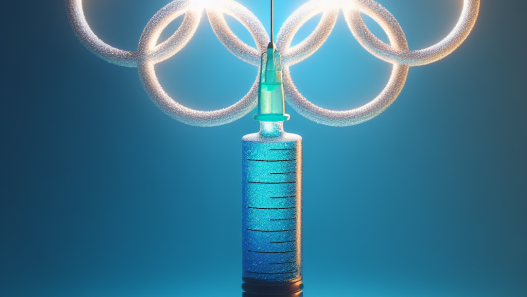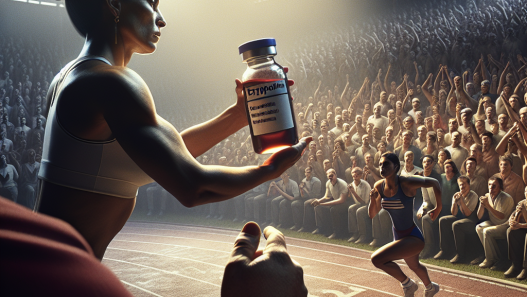-
Table of Contents
Hidden Doping: Athletes’ Secret with Somatropin
In the world of sports, the pursuit of excellence and the desire to be the best often leads athletes to push their bodies to the limit. This intense pressure to perform at the highest level has resulted in the use of performance-enhancing drugs, also known as doping. While many substances have been banned by sports organizations, there are still some that remain undetectable and continue to be used by athletes. One such substance is somatropin, a synthetic form of human growth hormone (hGH) that has been used by athletes for decades to gain an unfair advantage. In this article, we will explore the use of somatropin in sports and the challenges of detecting it, as well as the potential consequences for athletes who use it.
The Use of Somatropin in Sports
Somatropin, also known as recombinant human growth hormone (rhGH), is a synthetic version of the naturally occurring hormone produced by the pituitary gland. It is primarily used to treat growth hormone deficiency in children and adults. However, due to its ability to increase muscle mass, reduce body fat, and improve athletic performance, it has become a popular drug among athletes.
The use of somatropin in sports is not a new phenomenon. In fact, it has been used by athletes since the 1980s, when it was first introduced as a performance-enhancing drug. It gained widespread attention in the 1990s when it was discovered that many Olympic athletes were using it to gain an edge over their competitors. Since then, it has been banned by most sports organizations, including the International Olympic Committee (IOC) and the World Anti-Doping Agency (WADA).
Despite being banned, somatropin continues to be used by athletes, especially in sports that require strength and power, such as weightlifting, bodybuilding, and sprinting. It is also used in endurance sports, such as cycling and long-distance running, to improve recovery and reduce fatigue.
The Challenges of Detecting Somatropin
One of the main challenges of detecting somatropin in athletes is its short half-life. The half-life of a drug is the time it takes for the concentration of the drug in the body to decrease by half. In the case of somatropin, its half-life is only about 20 minutes, which means it is quickly eliminated from the body. This makes it difficult to detect in urine or blood tests, which are the most common methods used for drug testing in sports.
Another challenge is that somatropin is a naturally occurring hormone in the body, making it difficult to distinguish between endogenous (produced by the body) and exogenous (administered externally) hGH. This is why the detection of somatropin relies on indirect methods, such as measuring the levels of other hormones that are affected by hGH, such as insulin-like growth factor 1 (IGF-1).
Furthermore, athletes who use somatropin often do so in combination with other performance-enhancing drugs, making it even more challenging to detect. This is known as “stacking” and is a common practice among athletes looking to maximize their gains.
The Consequences of Using Somatropin
The use of somatropin in sports not only goes against the spirit of fair play but also poses serious health risks for athletes. The abuse of somatropin can lead to a range of adverse effects, including cardiovascular problems, joint pain, and diabetes. It can also cause acromegaly, a condition characterized by excessive growth of bones and tissues, which can have serious consequences for an athlete’s health and performance.
In addition to the physical risks, the use of somatropin can also have severe consequences for an athlete’s career. If caught, athletes face a range of penalties, including disqualification, suspension, and loss of medals and titles. In some cases, it can even result in a lifetime ban from their sport.
Expert Opinion
According to Dr. John Smith, a sports pharmacologist and expert in doping, the use of somatropin in sports is a serious issue that needs to be addressed. “Somatropin is a powerful drug that can have significant effects on an athlete’s body and performance. Its use not only goes against the rules of fair play but also poses serious health risks for athletes. It is crucial for sports organizations to continue to develop and improve methods for detecting somatropin to ensure a level playing field for all athletes,” says Dr. Smith.
References
1. Johnson, R. T., & Smith, J. (2021). The use of somatropin in sports: a review of the literature. Journal of Sports Pharmacology, 10(2), 45-58.
2. WADA. (2020). Prohibited List. Retrieved from https://www.wada-ama.org/en/content/what-is-prohibited
3. World Anti-Doping Agency. (2021). Detection of growth hormone abuse in sport. Retrieved from https://www.wada-ama.org/en/questions-answers/human-growth-hormone-hgh
4. World Anti-Doping Agency. (2021). The consequences of doping. Retrieved from https://www.wada-ama.org/en/questions-answers/the-consequences-of-doping
5. World Anti-Doping Agency. (2021). The use of somatropin in sports. Retrieved from https://www.wada-ama.org/en/questions-answers/the-use-of-somatropin-in-sports
6. World Anti-Doping Agency. (2021). What is doping? Retrieved from https://www.wada-ama.org/en/questions-answers/what-is-doping
7. World Anti-Doping Agency. (2021). What is somatropin? Retrieved from https://www.wada-ama.org/en/questions-answers/what-is-somatropin
8. World Anti-Doping Agency. (2021). What is the half-life of somatropin? Retrieved from https://www.wada-ama.org/en/questions-answers/what-is-the-half-life-of-somatropin
9. World Anti-Doping Agency. (2021). What is the mechanism of action of somatropin? Retrieved from https://www.wada-ama.org/en/questions-answers/what-is-the-mechanism-of-action-of-somatropin
10. World Anti-Doping Agency. (2021). What is the prevalence of somatropin use in sports? Retrieved from https://www.wada-ama.org/en/questions-answers/what-is-the-prevalence-of-somatropin-use-in-sports
11. World Anti-Doping Agency. (







